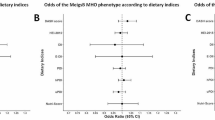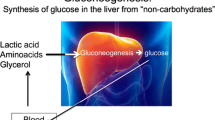Abstract
Background
Metabolic syndrome (MS) is becoming a major health risk in the world. Disorders of homeostasis are a trigger for MS and subsequent cardiometabolic diseases (CMDs). Its physiological role can be supported by biological protectors (BP). The purpose of this study is to develop a BP system for managing the MS development.
Methods
Within the framework of the case-control study, 3000 participants aged 20–60 years formed 2 groups: the main group and the control group.
Results
The study compared traditional markers of oxidative stress, chronic inflammation, and insulin resistance, which reflect the state of homeostasis. The BP system, proposed based on the concept of maintaining homeostasis, offers the following points for investigating the possibilities of therapeutic intervention: confronting dysregulation of homeostasis, resisting chronic inflammation and oxidative stress, resisting the consequences of disturbed homeostasis. This approach not only contributed to the understanding of general biological processes, but also provided a targeted search and development of BP to maintain the stability of homeostasis with MS.
Conclusions
The study results provided insight into new opportunities in the MS management.

Similar content being viewed by others
Change history
30 May 2023
This article has been retracted. Please see the Retraction Notice for more detail: https://doi.org/10.1007/s40200-023-01242-0
References
McMillen IC, Robinson JS. Developmental origins of the metabolic syndrome: prediction, plasticity, and programming. Phys Rev. 2005;85:571–633. https://doi.org/10.1152/physrev.00053.2003.
Aleksandrova K, Mozaffarian D, Pischon T. Addressing the perfect storm: biomarkers in obesity and pathophysiology of cardiometabolic risk. Clin Chem. 2018;64(1):142–53. https://doi.org/10.1373/clinchem.2017.275172.
Figueira I, Fernandes A, Mladenovic Djordjevic A, Lopez-Contreras A, Henriques CM, Selman C, Ferreiro E, Gonos ES, Trejo JL, Misra J, Rasmussen LJ, Xapelli S, Ellam T, Bellantuono I. Interventions for age-related diseases: shifting the paradigm. Mech Age Devel. 2016;160:69–92.
Veen LV, Morra J, Palanica A, Fossat Y. Homeostasis as a proportional-integral control system. NPJ Dig Med. 2020;3:77. https://doi.org/10.1038/s41746-020-0283-x.
Simmons RK, Alberti KGMM, Gale EAM, Colagiuri S, Tuomilehto J, Qiao Q, Ramachandran A, Tajima N, Brajkovich Mirchov I, Ben-Nakhi A, Reaven G, Hama Sambo B, Mendis S, Roglic G. The metabolic syndrome: useful concept or clinical tool? Diabet. 2010;53:600–5. https://doi.org/10.1007/s00125-009-1620-4.
Yizhak K, Gabay O, Cohen H, Ruppin E. Model-based identification of drug targets that revert disrupted metabolism and its application to ageing. Nat Commun. 2013;4:2632. https://doi.org/10.1038/ncomms3632.
Moskalev A, Chernyagina E, Kudryavtseva A, Shaposhnikov M. Geroprotectors: a unified concept and screening approaches. Ag Dis. 2017;8(3):354–63. https://doi.org/10.14336/AD.2016.1022.
Kotas ME, Medzhitov R. Homeostasis, inflammation, and disease susceptibility. Cell. 2015;160(5):816–27. https://doi.org/10.1016/j.cell.2015.02.010.
Emanuelli B, Eberlé D, Suzuki R, Kahn CR. Overexpression of the dual-specificity phosphatase MKP-4/DUSP-9 protects against stress-induced insulin resistance. Proceed Nat Acad Sci USA. 2008;105(9):3545–50. https://doi.org/10.1073/pnas.0712275105.
Flaa A, Aksnes TA, Kjeldsen SE, Eide I, Rostrup M. Increased sympathetic reactivity may predict insulin resistance: an 18-year follow-up study. Metabolism. 2008;57(10):1422–7. https://doi.org/10.1016/j.metabol.2008.05.012.
Carnagarin R, Matthews VB, Herat LY, Ho JK, Schlaich MP. Autonomic regulation of glucose homeostasis: a specific role for sympathetic nervous system activation. Cur Diab Rep. 2018;18:107. https://doi.org/10.1007/s11892-018-1069-2.
Armani A, Berry A, Cirulli F, Caprio M. Molecular mechanisms underlying metabolic syndrome: the expanding role of the adipocyte. FASEB J. 2017;31(10):4240–55. https://doi.org/10.1096/fj.201601125RRR.
Vona R, Gambardella L, Cittadini C, Straface E, Pietraforte D. Biomarkers of oxidative stress in metabolic syndrome and associated diseases. Oxid Med Cell Long. 2019;8267234 https://doi.org/10.1155/2019/8267234.
Li S, Fei Z, Xu Z, Wang J, Jiang Z, Ya X, Yu W, Huang W, Sun H. Enterococcus faecalis sir2-like gene enhances aerobic metabolism of themselves and mitochondrial respiration of mammal cells to bring about improving metabolic syndrome through the PGC-1 α pathway. J Tiss Eng Regen Med. 2018;13:143–55. https://doi.org/10.1002/term.2775.
Goyal A, Terry PD, Superak HM, Nell-Dybdahl CL, Chowdhury R, Phillips LS, Kutner MH. Melatonin supplementation to treat the metabolic syndrome: a randomized controlled trial. Diabet Metab Synd. 2014;6:124–32.
Fatima N, Rana S. Metabolic implications of circadian disruption. Pflüg Arch: Europ J Phys. 2020;472:513–26. https://doi.org/10.1007/s00424-020-02381-6.
Kim J, Lim YM, Lee MS. The role of autophagy in systemic metabolism and human-type diabetes. Molec Cells. 2018;41(1):11–7. https://doi.org/10.14348/molcells.2018.2228.
Czech MP. Mechanisms of insulin resistance related to white, beige, and brown adipocytes. Molec Metab. 2020;34:27–42. https://doi.org/10.1016/j.molmet.2019.12.014.
Nishiyama K, Fujimoto Y, Takeuchi T, Azuma YT. Aggressive crosstalk between fatty acids and inflammation in macrophages and their influence on metabolic homeostasis. Neurochem Res. 2018;43(1):19–26. https://doi.org/10.1007/s11064-017-2269-x.
Aliper A, Jellen L, Cortese F, Artemov A, Karpinsky-Semper D, Moskalev A, Swick AG, Zhavoronkov A. Towards natural mimetics of metformin and rapamycin. Aging (Albany NY). 2017;9(11):2245–68. https://doi.org/10.18632/aging.101319.
Kim EC, Kim JR. Senotherapeutics: emerging strategy for healthy aging and age-related disease. BMB Rep. 2019;52(1):47–55. https://doi.org/10.5483/BMBRep.2019.52.1.293.
Kovalenko M, Bilyi D. Prognostic value of vascular invasion in breast tumours in she-dogs (pilot study). Scient Horizons. 2021;24(2):54–61.
Chala I, Feshchenko D, Dubova O, Zghozinska O, Solodka L, Sokulskyi I. Blood lipid profile as a diagnostic marker of acute pancreatitis in dogs. Scient Horizons. 2021;24(1):14–21.
Funding
The study was carried out within the framework of the technological programme BR05236375 “Study of the features concerning genetic risk of diseases associated with metabolic syndrome in the Kazakh population, by order of the State Institution “Committee of Science under the Ministry of Education and Science of the Republic of Kazakhstan”.
Author information
Authors and Affiliations
Corresponding author
Ethics declarations
Conflict of interest
There are no conflicts of interest to declare.
Additional information
Publisher’s note
Springer Nature remains neutral with regard to jurisdictional claims in published maps and institutional affiliations.
This article has been retracted. Please see the retraction notice for more detail: https://doi.org/10.1007/s40200-023-01242-0
Rights and permissions
Springer Nature or its licensor (e.g. a society or other partner) holds exclusive rights to this article under a publishing agreement with the author(s) or other rightsholder(s); author self-archiving of the accepted manuscript version of this article is solely governed by the terms of such publishing agreement and applicable law.
About this article
Cite this article
Benberin, V.V., Sibagatova, A.S., Nagimtayeva, A.A. et al. RETRACTED ARTICLE: Systematisation of biological protectors for managing the metabolic syndrome development. J Diabetes Metab Disord 20, 1449–1454 (2021). https://doi.org/10.1007/s40200-021-00883-3
Received:
Accepted:
Published:
Issue Date:
DOI: https://doi.org/10.1007/s40200-021-00883-3




